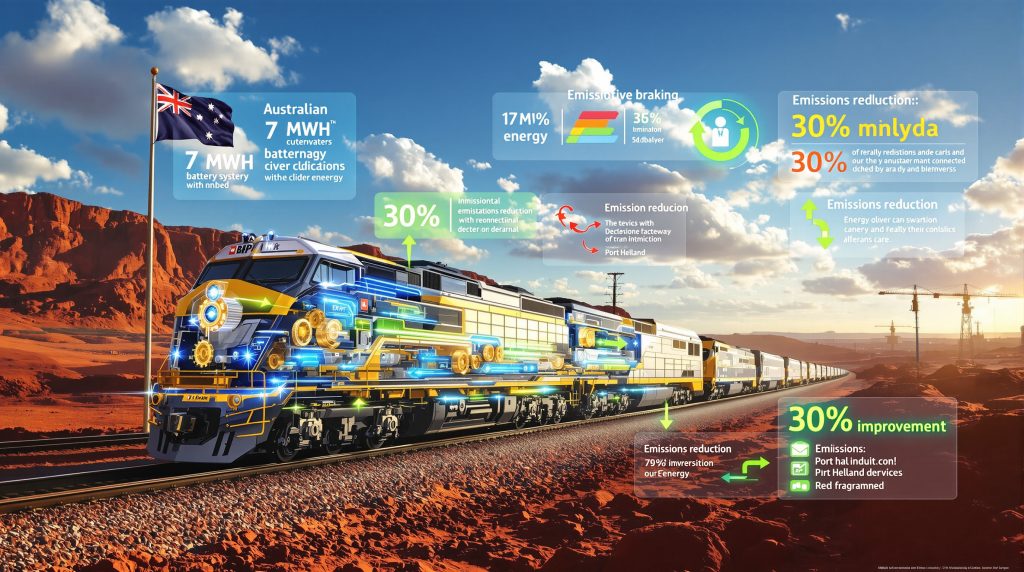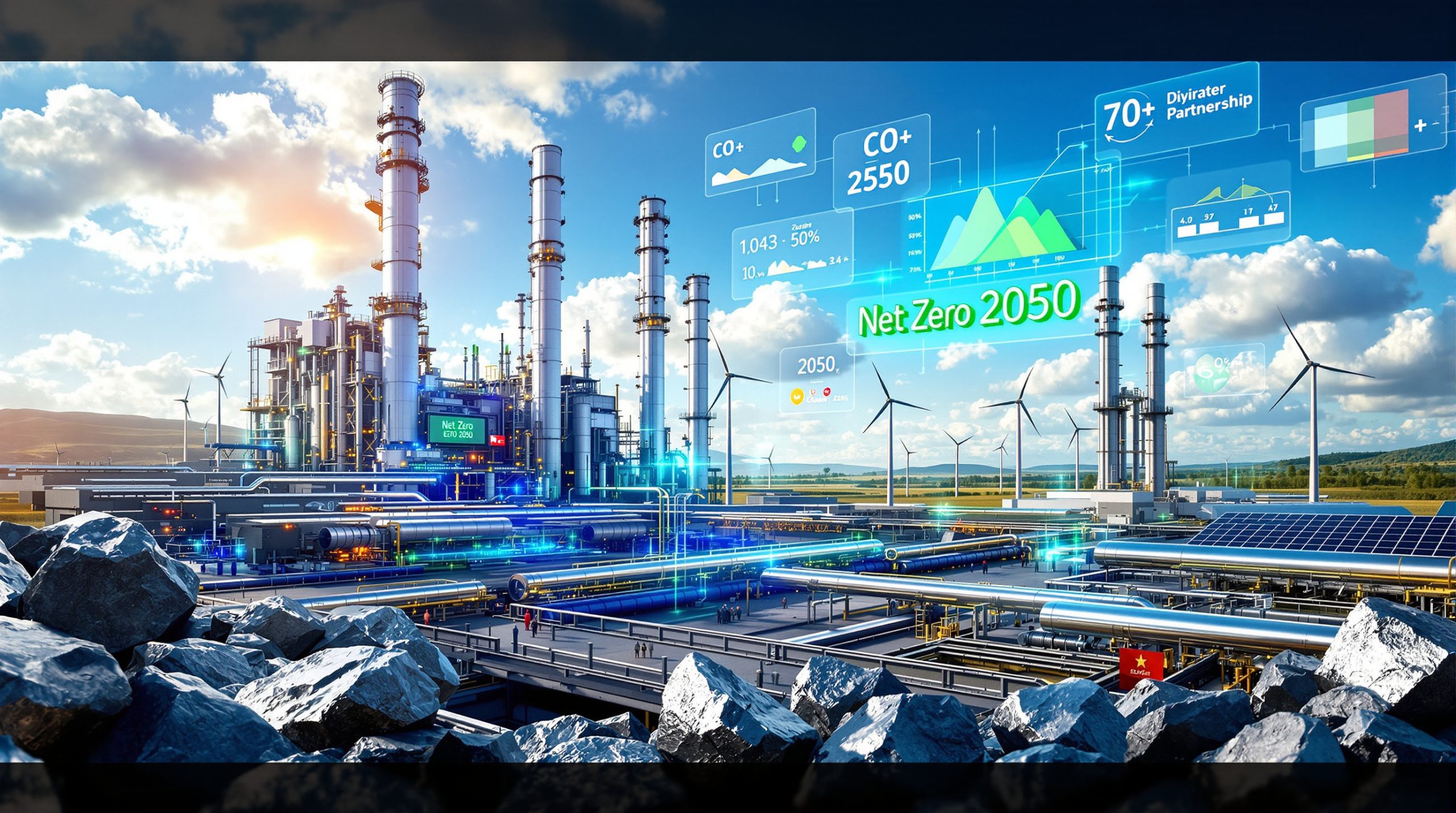What Makes BHP's Battery-Electric Locomotive Delivery Groundbreaking?
BHP takes delivery of battery-electric locomotives represents a transformative moment for Australia's mining sector. These two heavy-haul units, now stationed in Port Hedland, demonstrate how major mining companies are pivoting from traditional diesel-powered rail systems toward environmentally conscious alternatives that maintain operational excellence.
Furthermore, the significance extends beyond environmental benefits, showcasing advanced engineering capabilities specifically designed for Australia's extreme mining conditions. The Pilbara region presents unique challenges including intense heat, dust contamination, and demanding operational schedules that require robust engineering solutions.
Key Delivery Specifications:
- Two battery-electric locomotives delivered to Port Hedland
- 7 MWh battery capacity per unit
- Partnership with Wabtec Corporation for technology development
- Purpose-built design for Pilbara iron ore operations
According to BHP Western Australia Iron Ore Asset President Tim Day, these locomotives represent years of strategic planning and partnership development. The delivery exemplifies the innovation necessary to maintain Pilbara operations while advancing sustainability objectives across the mining value chain.
Technical Innovation Behind Battery-Electric Mining Locomotives
Advanced Battery Systems and Energy Storage
Each locomotive incorporates a sophisticated 7 MWh battery system, representing cutting-edge energy storage technology adapted for heavy industrial applications. This substantial battery capacity enables extended operational periods whilst maintaining the power output necessary for hauling massive iron ore loads across demanding terrain.
Moreover, the battery systems are engineered specifically for mining environments, incorporating thermal management systems capable of maintaining performance in temperatures exceeding 40°C. This represents a significant technological achievement, as conventional battery systems typically experience performance degradation under such extreme conditions.
Battery System Capabilities:
| Component | Specification | Performance Benefit |
|---|---|---|
| Energy Storage | 7 MWh per unit | Extended operational range |
| Thermal Management | 40°C+ operation | Consistent performance in extreme heat |
| Integration | Regenerative braking | Energy recovery optimisation |
| Durability | Mining-grade design | Reduced maintenance requirements |
In addition, the locomotives feature innovative regenerative braking systems that capture kinetic energy during downhill operations and convert it back into stored electrical power. This technology proves particularly valuable in the Pilbara's topographical conditions, where loaded trains descend from mining sites toward port facilities, creating natural energy recovery opportunities.
How Does Regenerative Braking Technology Maximise Efficiency?
The regenerative braking implementation represents sophisticated energy management tailored to mining rail operations. During downhill phases with loaded iron ore cars, the system captures braking energy that would otherwise be lost as heat, converting it into electrical power stored in the locomotive's battery system.
Energy Recovery Framework:
- Captured braking energy reduces overall power consumption
- Extended operational range per charge cycle
- Optimised performance for specific Pilbara route topography
- Reduced wear on conventional braking components
Consequently, this energy recovery proves especially effective given the Pilbara's geography, where mining sites are typically located at higher elevations than port facilities. The natural descent gradient creates consistent opportunities for energy capture during the most demanding operational phases, aligning with broader mining innovation trends emerging across the industry.
Environmental Impact and Emissions Reduction Potential
Quantifying Carbon Footprint Improvements
The transition to battery-electric locomotives offers substantial environmental advantages for large-scale mining operations. These systems directly address both Scope 1 emissions from direct diesel combustion and Scope 2 emissions from purchased electricity, creating comprehensive decarbonisation potential.
Emissions Classification Framework:
- Scope 1 Reduction: Complete elimination of diesel combustion emissions
- Scope 2 Optimisation: Grid electricity carbon intensity dependency
- Operational Impact: Zero tailpipe emissions during locomotive operation
- Lifecycle Considerations: Battery production and end-of-life management
Disclaimer: Emissions reduction calculations depend on electricity grid carbon intensity and operational patterns. Actual performance may vary based on charging infrastructure, maintenance schedules, and regional grid composition.
When powered by renewable energy sources, these systems can achieve near-zero operational emissions, fundamentally transforming the carbon profile of rail-based mining logistics. This represents a complete decoupling of mining transportation from fossil fuel dependency whilst maintaining full operational capability, supporting the broader mining decarbonisation benefits recognised across the sector.
Scope 1 and 2 Emissions Transformation
Battery-electric locomotives eliminate Scope 1 emissions by removing diesel combustion as the primary power source. This eliminates direct carbon dioxide, methane, and nitrous oxide emissions at the point of use, creating immediate environmental benefits for mining operations.
Scope 2 emissions optimisation depends on electricity grid composition:
- Renewable-powered grids: Near-zero Scope 2 emissions
- Conventional grids: Reduced but non-zero Scope 2 emissions
- Hybrid systems: Proportional emissions based on renewable percentage
- Corporate procurement: Direct renewable energy purchasing potential
However, the locomotives are designed to integrate with renewable energy systems, including solar and wind power installations common at mining sites. This integration creates opportunities for complete operational carbon neutrality whilst providing energy storage capabilities for broader mining site electrical systems, supporting renewable integration in mining initiatives.
Real-World Testing and Performance Validation
Pilbara Trial Programme Objectives
The commissioning process involves comprehensive track trials designed to evaluate performance under authentic operating conditions. These trials assess locomotive capabilities across multiple operational parameters crucial for successful mining rail operations.
Comprehensive Evaluation Criteria:
- Load Capacity Testing: Maximum iron ore payload handling under extreme conditions
- Thermal Performance: Battery system functionality in 40°C+ temperatures
- Energy Consumption Analysis: Real-world consumption patterns across different routes
- Maintenance Optimisation: Component reliability and service interval requirements
- Infrastructure Integration: Compatibility with existing BHP rail systems
Furthermore, the trial programme represents genuine performance validation under conditions that laboratory testing cannot replicate. The combination of extreme heat, dust contamination, heavy cargo loads, and continuous operational cycles provides authentic stress testing for all locomotive systems.
What Operational Challenges Must Be Overcome?
Mining rail operations present unique engineering challenges that battery-electric locomotives must overcome whilst maintaining performance reliability. The Pilbara environment creates particularly demanding conditions that test all aspects of locomotive design and operation.
Critical Performance Factors:
- Thermal Management: Consistent power delivery in temperatures exceeding 40°C
- Dust Resistance: Component protection from airborne particles and contamination
- Load Handling: Heavy iron ore payload capacity maintenance across operational cycles
- Rapid Charging: Efficient energy replenishment between operational runs
Consequently, the locomotives incorporate specialised dust filtration systems, enhanced cooling mechanisms, and ruggedised electrical components designed specifically for mining environments. These features ensure consistent performance despite the challenging operational conditions inherent to Pilbara mining operations, contributing to data-driven mining operations that optimise performance through real-time monitoring.
Industry Partnership and Technology Development
Wabtec Collaboration and Engineering Excellence
BHP takes delivery of battery-electric locomotives through their partnership with Wabtec Corporation demonstrates the collaborative approach necessary for developing specialised mining equipment. This partnership combines BHP's operational expertise and understanding of Pilbara conditions with Wabtec's locomotive engineering capabilities and battery system integration experience.
Partnership Benefits Include:
- Specialised design for Australian mining conditions
- Integrated maintenance and technical support systems
- Continuous technology improvement and optimisation programmes
- Knowledge transfer for broader industry advancement
Moreover, the collaboration extends beyond equipment delivery to encompass ongoing technology development, maintenance protocols, and performance optimisation. This comprehensive approach ensures long-term operational success and provides a foundation for potential fleet expansion.
Manufacturing and Supply Chain Considerations
The development of battery-electric locomotives requires sophisticated supply chains capable of producing high-capacity battery systems, advanced control electronics, and ruggedised components suitable for mining applications. This represents a significant evolution in locomotive manufacturing priorities and capabilities.
Supply Chain Requirements:
- Battery Manufacturing: High-capacity, mining-grade battery cell production
- Electronics Integration: Advanced control systems and power management
- Component Durability: Mining-environment qualified mechanical components
- Support Infrastructure: Specialised maintenance and technical support capabilities
Economic Implications for Mining Operations
Operational Cost Analysis
Whilst initial capital investment for battery-electric locomotives exceeds traditional diesel units, long-term operational cost benefits create favourable total cost of ownership scenarios. The economic analysis encompasses multiple cost factors that improve over the locomotive's operational lifetime.
Cost Consideration Framework:
| Cost Category | Initial Impact | Long-term Trend |
|---|---|---|
| Capital Investment | Higher upfront costs | Amortised over operational life |
| Fuel Expenses | Eliminated diesel costs | Electricity cost dependency |
| Maintenance | Specialised battery service | Reduced mechanical maintenance |
| Carbon Pricing | Immediate compliance benefit | Increasing advantage over time |
| Energy Predictability | Grid electricity pricing | Long-term contract potential |
In addition, the total cost of ownership calculation becomes increasingly favourable as battery technology costs decline and carbon pricing mechanisms expand. Energy cost predictability through renewable energy contracts provides additional economic advantages compared to volatile diesel pricing.
Infrastructure Investment Requirements
Successful battery-electric locomotive deployment requires supporting infrastructure including charging stations, electrical grid connections, and maintenance facilities adapted for battery systems. These infrastructure investments represent significant capital commitments but enable long-term operational transformation.
Infrastructure Development Components:
- Charging Infrastructure: High-capacity charging stations at operational hubs
- Grid Integration: Electrical connection upgrades for increased power demand
- Maintenance Facilities: Battery system service and diagnostic capabilities
- Energy Storage: Grid-scale battery systems for operational flexibility
Future Implications for Australian Mining
Industry-Wide Adoption Potential
BHP takes delivery of battery-electric locomotives could catalyse broader adoption across Australia's mining sector, where rail transport plays a crucial role in commodity logistics. The demonstration of technical feasibility and economic viability may accelerate similar electrification programmes among other major mining companies.
Sector Transformation Indicators:
- Competitive pressure for sustainability initiatives and emissions reduction
- Regulatory support for industrial decarbonisation programmes
- Technology cost improvement trajectories favouring battery systems
- Infrastructure development momentum supporting electrification
Furthermore, Australia's position as a leading global mining nation means successful battery-electric locomotive implementation could influence international industry standards and practices. The Pilbara trials may establish performance benchmarks for similar operations worldwide, particularly in regions with comparable operational challenges, supporting battery metals investment strategies globally.
Global Mining Industry Leadership
The successful deployment of battery-electric locomotives in one of the world's most demanding mining environments demonstrates technological maturity and operational viability. This achievement positions Australia as a leader in mining industry decarbonisation and sustainable technology adoption.
International Influence Factors:
- Technology Validation: Proof of concept in extreme operational conditions
- Performance Benchmarks: Operational data for global industry reference
- Best Practices Development: Maintenance, integration, and optimisation protocols
- Supply Chain Evolution: Component manufacturing and support infrastructure development
Technology Evolution and Future Development
Battery Technology Advancement Trends
Ongoing improvements in battery energy density, charging speed, and thermal management will enhance locomotive performance capabilities. Future generations may achieve extended range, faster charging cycles, and improved reliability under extreme conditions.
Technology Development Priorities:
- Higher Energy Density: Improved battery chemistries for extended operational range
- Faster Charging Systems: Reduced downtime between operational cycles
- Advanced Thermal Management: Enhanced performance in extreme temperature environments
- Predictive Maintenance: AI-driven component monitoring and optimisation
However, the integration of advanced materials science, artificial intelligence, and renewable energy systems will continue improving battery-electric locomotive capabilities. These developments will enhance both environmental performance and operational efficiency across mining applications.
Integration with Renewable Energy Systems
Battery-electric locomotives create opportunities for integration with renewable energy generation, including solar and wind power systems common at mining sites. This integration enables complete carbon neutrality for rail operations whilst providing energy storage capabilities for mining site electrical systems.
Renewable Integration Benefits:
- Operational Carbon Neutrality: Zero-emission rail transport
- Grid Stability: Locomotive batteries as distributed energy storage
- Energy Cost Optimisation: Reduced exposure to fossil fuel price volatility
- Sustainability Certification: Enhanced environmental credentials for commodity exports
Consequently, BHP's battery electric locomotives represent a significant milestone in the transition toward sustainable mining transportation solutions.
Regulatory Environment and Policy Support
Australian Government Sustainability Initiatives
Government policies supporting industrial decarbonisation and renewable energy adoption create favourable conditions for battery-electric locomotive deployment. These policy frameworks include incentives, grants, and regulatory requirements that accelerate sustainable technology adoption across mining operations.
Policy Support Mechanisms:
- Carbon Pricing Systems: Economic incentives for emissions reduction
- Technology Grants: Government funding for innovation and deployment
- Infrastructure Investment: Public investment in renewable energy grid expansion
- Regulatory Frameworks: Environmental compliance requirements driving adoption
International Climate Commitments Impact
Australia's international climate commitments influence corporate sustainability strategies, making emissions reduction technologies like battery-electric locomotives increasingly important for maintaining social licence to operate and accessing international commodity markets.
Moreover, the growing emphasis on environmental, social, and governance (ESG) criteria in investment decisions and commodity purchasing creates additional incentives for mining companies to adopt sustainable technologies. Battery-electric locomotives demonstrate tangible progress toward decarbonisation commitments, as highlighted by Australian Mining's coverage of this groundbreaking initiative.
Mining Sector Transformation Through Electrification
BHP takes delivery of battery-electric locomotives marks a pivotal moment in mining industry evolution. These advanced systems demonstrate that heavy industrial operations can successfully integrate sustainable technologies without compromising operational performance or economic viability.
Furthermore, the success of this trial programme will likely influence industry-wide adoption patterns, regulatory frameworks, and technology development priorities. As battery technology continues improving and supporting infrastructure expands, battery-electric locomotives may become the standard for new mining rail operations worldwide.
Key Success Factors:
- Technical Performance: Demonstration of operational capability in extreme conditions
- Economic Viability: Favourable total cost of ownership compared to diesel alternatives
- Environmental Benefits: Significant emissions reduction potential with grid decarbonisation
- Industry Leadership: Positioning Australia at the forefront of mining sector sustainability
This transformation represents more than technological advancement—it demonstrates the mining industry's commitment to environmental stewardship whilst maintaining the operational excellence necessary for global commodity supply chains. The integration of advanced battery systems, renewable energy, and sophisticated control technologies creates new possibilities for sustainable mining operations.
In addition, the implications extend beyond individual mining companies to encompass entire supply chains, from equipment manufacturers to commodity end-users. As the technology proves its capabilities in demanding applications like iron ore transport, broader adoption across mining, freight, and industrial sectors becomes increasingly viable.
Investment Disclaimer: Technology adoption timelines and performance characteristics may vary based on operational conditions, regulatory changes, and market dynamics. Stakeholders should conduct independent analysis before making investment or operational decisions.
Ready to Capitalise on Mining's Technology Revolution?
Discovery Alert's proprietary Discovery IQ model delivers real-time alerts on significant ASX mineral discoveries, instantly empowering subscribers to identify actionable opportunities in innovative mining companies embracing sustainable technologies. Understand why major mineral discoveries can lead to substantial market returns by exploring Discovery Alert's dedicated discoveries page, showcasing historic examples of exceptional outcomes, and begin your 30-day free trial today to position yourself ahead of the market.




